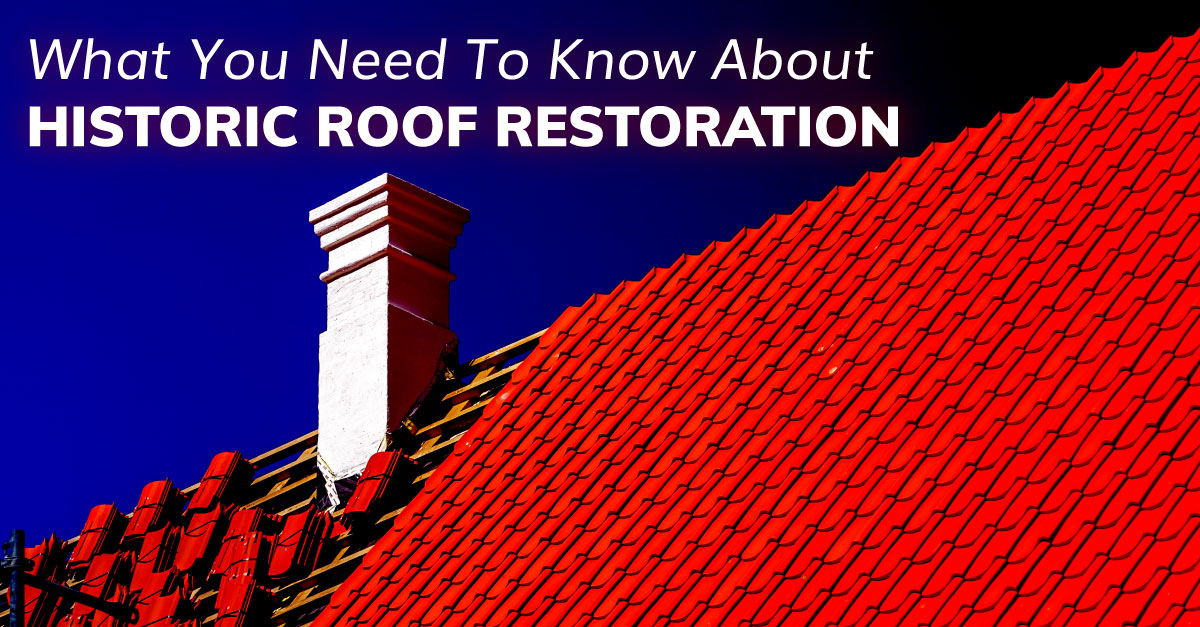
A historic roof is not simply an old roof. It forms an integral part of the building’s character and historical significance. In historic buildings, roof repair or restoration has a lot more to the job than you would imagine. To maintain the original design, style, and materials of a historic building, you need to hire a professional with a working knowledge of these monumental structures.
What Constitutes a Historic Roof
If you own a structure with historical significance, you need to understand what to expect from your roof restoration. But first, what really constitutes a historic roof?
A historic home is part of an architectural style, and the roof was a significant focus of these traditional styles, such as Victorian or Georgian.
In general, historic roofs featured the following roofing materials:
- Wood Shingles/ Shakes: Wood type shingles are an all-time roofing material which could be treated or dyed.
- Clay Tile: Clay tiles gained popularity from the 17th century.
- Slate: This versatile roofing material came into the limelight in the 18th century.
- Metal Roofs: Metal roofs were rare before the 19th century but later came in several styles and materials.
- Shingles: Asphalt shingles gained traction in the 20th century with the earliest models looking like modern 3-tab shingles.
Types of Buildings with Historic Roofs
There are several types of buildings which feature historic roofs. Here is a quick overview of historic building styles, their architectural features, and the likely materials used on them:
- Spanish Colonial: These building styles are common in South and West America and borrowed a lot from the Spanish influence. You can find them in simple homes and elaborate and Baroque churches. Clay tile is the common roofing material for these buildings.
- New England Colonial, French Colonial, and Dutch Colonial: These buildings feature steep rooflines or gables and are often covered with wood shingles/shakes. They largely borrow from British and other European influences.
- Georgian Style: These structures feature paired chimneys, gable, or hip roofs. They are mostly covered with wood shingles.
- Federal Style: These historic homes have simple gables or hips with balustrades and are mostly roofed with wood shingles or slate.
- Italianate Style: They feature hipped roofs with eaves and ornamentation and are roofed mostly with clay tiles.
- Greek Revival: Feature gable roofs and embellishment with metal or wood shingles.
- Gothic Revival: These are mostly steep pitch, multiple gables covered with slate.
- Queen Anne: Feature turrets, balconies, bay windows, and very ornamental styles. They are mostly roofed with wood or slate.
- Second Empire Style: They generally have mansard roofs covered with slate with iron ornamentation.
- Craftsman Style: Feature low-pitched, large roofs with highly visible rafter tails. They are mostly covered with wood shingles or asphalt shingles.
- Bungalow Style: Have low-pitched, simple roofs with wood shingles or asphalt shingles.
The Restoration Process for Historical Roofs
The process of restoring a historical roof can be painstaking. It starts with a meticulous assessment to determine what is wrong with the roof and where water intrusion is making its way into the building.
An experienced roofer will also evaluate whether the old roofing system is simply experiencing natural wear and tear or there are underlying problems which need to be fixed before replacing the roofing materials.
More often, these assessments require your roofing contractor to check the attic and see what is happening under the surface. Even this preliminary work requires an expert to ensure the roofing system sustains no further damage during the inspection.
Moreover, roofing materials for historic buildings are delicate and should not be walked on. Your roofer will need to use proper scaffolding and other equipment to ensure the investigation is non-invasive.
How Repairing Historic Roofs Differs from Regular Roofs
The repair process for a historic roof can be a challenge. In many cases, the original roofing materials are no longer available, meaning proper substitutes must be located. These substitutes must look no different from the original materials, and should be compatible with other materials already on the roof. Combining incompatible metals usually results in corrosion or damage. Otherwise, repairs need to be done at a time when the weather is mild to avoid moisture damage to the delicate roofing materials.
Why Restore a Historic Roof
While the primary goal of restoring a historic roof is to address leaks and other weather damages, maintaining the original, rustic style of a historic building is equally important. Always work with a roofing contractor who understands the craft practices used at the time. Although you can’t find hand-split wooden shingles commercially available today, your roofer should locate a modern craftsman to expertly reproduce the products.
Overall, historic roof restoration is a highly specialized venture which requires not only skills and knowledge but also a passion for detail and the rich history involved in each project. At Stevens Roofing, we have been restoring a wide range of historic roofs dating back to the 17th century. Contact us today to schedule a free inspection of your historic building in Norfolk, VA.





